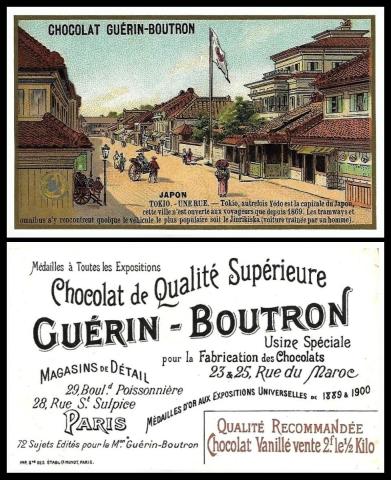
So why do we have this card, of Tokyo?
Well there are three reasons.
The first is that the first time that prison inmates were routinely fingerprinted was in Japan in 1908.
The second, that the police force in Tokyo began adding fingerprinting to their list of detection tools just three years later.
But the third is the most important, as it was a missionary doctor in Japan who first wrote a paper explaining how fingerprints could be used to solve crime.
His name was Henry Faulds, and he was born in Scotland in 1843. He arrived in Japan in 1874, newly married, and coming via India, where he had been working in a hospital for two years. His task was to set up a mission and hospital based in Tokyo, and this occupied the first few years of his stay. Then, in 1878, he went on a trip with a friend to an archaeological dig, in Tokyo. Whilst there, he found some pieces of discarded pottery, and was amazed that some of them still showed signs of the prehistoric potter`s hands, left visible for all time, as they just went about their trade and worked the clay. He took several pieces home and studied them, and one day the light was just perfect and it even illuminated the tiny ridges that were on the potter`s finger tips. This fired him up (bad pottery pun, sorry). He also used his knowledge to solve a crime, for during his initial observations there was a break in at the hospital and a man was arrested. Faulds did not believe this man guilty and set about investigating on his own, by using fingerprints taken from the room and from the man in custody. These did not match and, quite amazingly, the police let the innocent man go free.
In 1880 Faulds had reached the stage of writing a letter about how you could use marks on the hand to identify a person, and sending it up to the journal "Nature", which was devoted not just to animal and plant nature but to many other branches of science. This was published, as "On the Skin Furrows of the Hand", in the October edition, and you can read all about what happened after that at
http://www.yoshabunko.com/fingerprinting/Fingerprinting_Japan.html
https://galton.org/fingerprints/faulds.htm
So on to the story of our card, and to Guerin Boutron, the issuer. This is fascinating, and lengthy. The company was founded, in 1775, by a man called Pierre-Joseph Roussel, who is recorded as being a grocer and chemist, though maybe this just means that he sold medication as part of his wares.
He had started making chocolate in 1769, but not as a block, as a syrup, or pouring chocolate, in a bottle, and advertising it as "Chocolat Oriental". The block chocolate came later in 1775. When he died in 1805 his wife took charge, and under her stewardship it attracted the attention of none other than The Duke of Bordeaux, who allowed her to add his name to their advertising and packaging. Towards the end of her life her son in law took control. And it remained in the family, through a succession of sons in law, though it did frequently relocate.
The cards were issued, in sets of six, between 1870 and 1920.
The company was bought by another grocer, and card issuer, Felix Potin in 1942.
Now there is the most amazing website devoted to this manufacturer, with a long biography, albeit in French. However the site also showcases many of their beautiful cards and is definitely well worth visiting. The link is
https://www.vivachocolat.fr/dictionnaire-des-chocolateries/france/guerin-boutron
They also have an instagram site, where several cards appear - this is at
https://www.instagram.com/chocolatguerinboutron/?hl=en-gb
